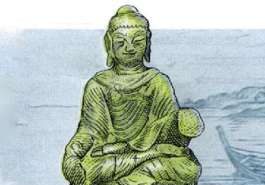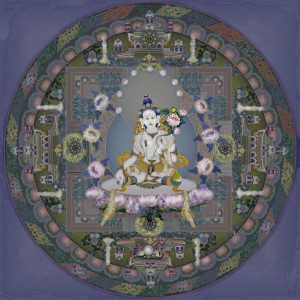
How does a buddha come to deliver ordinary beings?
At the beginning of the Infinite Life Sutra, Shakyamuni Buddha introduced the Dharma assembly, including the great arhats, the sacred bodhisattvas, and the benevolent householders. The Buddha praises their virtuous practice as follows:
“Each of these bodhisattvas, following the virtues of the Mahasattva Samantabhadra, is endowed with the immeasurable practices and vows of the Bodhisattva Path, and firmly dwells in all the meritorious deeds. He freely travels in all the ten quarters and employs skilful means of emancipation. He enters the treasury of the Dharma of the Buddhas, and reaches the Other Shore. Throughout the innumerable worlds he attains Enlightenment.”
Taking himself as an example, Shakyamuni Buddha also elucidates the eight stages of a Buddha’s life to show how a perfectly enlightened one goes about saving sentient beings. These are:
1. Dwelling in the Tusita Heaven;
2. Descending into his mother’s womb;
3. Being born as a prince;
4. Leaving home to become a renunciate;
5. Conquering Mara and his demons;
6. Attaining perfect Enlightenment;
7. Turning the Dharma Wheel;
8. Entering Nirvana.
Five kinds of relationship between a buddha and sentient beings
Before Shakyamuni Buddha introduced Amitabha Buddha in the Infinite Life Sutra, he summarized the five kinds of relationship between a buddha and sentient beings. He did this to clarify the reasons why bodhisattvas aspire to perfect enlightenment and the state of buddhahood. He said:
1. “Without being asked to do so, he becomes a good friend to each of the multitude of beings.”
2. “. . . and carries their heavy karmic burdens on his back.” He upholds the Tathagata’s profound Dharma-treasury and protects the seeds of buddhahood, so that they may continue to multiply. Having awakened great compassion for sentient beings, he kindly expounds the teaching and endows them with the Dharma-eye.
3. He blocks the paths to the three evil realms, opens the gate of virtue and “without waiting for their request, provides sentient beings with the Dharma.”
4. “He does this for the multitude of beings just as a dutiful son loves and respects his parents.”
5. “He indeed looks upon sentient beings as his own self.”
In summary, the five kinds of relationships are:
1. A good friend;
2. A hardworking servant;
3. A generous donor;
4. A dutiful son;
5. His own self.
This reveals the boundless compassion of all buddhas and bodhisattvas who earnestly make vows and zealously practice in order to deliver and benefit all suffering sentient beings with heavy karmic offenses.
Why is a buddha our good friend without being invited?
What is meant by, “Without being asked to do so, he becomes a good friend to each of the multitude of beings?” This indicates that a buddha proactively comes to befriend and help us. As we could not know Amitabha Buddha in his former incarnation as Dharmakara Bodhisattva (who attained perfect enlightenment 10 kalpas ago), how can we associate with Amitabha Buddha if he does not approach and pro-actively befriend us?
Do we have a good friend in our life who always accompanies us without forsaking? There are thousands of reasons why we end friendships with other people. Actually, all phenomena are impermanent in the world, including friendship, love, and so on. However, Amitabha’s friendship with sentient beings is true and genuine, eternal and boundless, life after life.
Although a buddha dwells in a state of purity and is perfect in all wisdom and virtue, he does not despise iniquitous ordinary beings like us. Why does Amitabha Buddha want to become our friend? It is because he wants to carry our heavy karmic burdens on his back—such is his care and accommodation!
Our world is a realm of suffering. We suffer because of our karmic offenses of ignorance, greed, and hatred. All sentient beings have their own karmic debts accumulated over many lives, and each karmic debt must be paid in full before we can exit the cycle of rebirth and endless suffering. But karmically speaking, we are destitute beggars without the means to pay even a single debt in full.
However, having awakened great compassion for sentient beings, a buddha blocks the paths to the three wretched realms and opens the gateway of virtue. Without waiting for our request, he bestows on us the teaching of deliverance and dedicates his merit and virtues to us so that we can pay our karmic debts and find permanent relief from all suffering.
A teaching for which we don’t know how to ask
As foolish beings, we do not know how to help ourselves. Even when a buddha appears in our world, ordinary people fail to ask him the right questions. Why do we not know how to make a request to a buddha for his teaching of deliverance? It is because the Buddhadharma, particularly the teaching of Amitabha’s deliverance, is extremely profound and ordinary beings are blinded by their attachments and false thinking.
If we do not know that we reincarnate within the Six Realms life after life, how can we ask for the way to liberate ourselves from the endless cycle of birth and death? We fail to understand that this is the root source of all sufferings as we have no experience of true and real happiness, like bodhisattvas do.
It is a compassionate buddha who takes the initiative to become like a filial son, showing love and respect us his parents. In fact, it should be the other way around: we should be the filial sons and daughters of Amitabha Buddha!
The Buddha further tells us: “I indeed look upon you as my own self.” Every time I read this passage in the Infinite Life Sutra, I cry. I am so moved by the unconditional love of the Buddha. I feel ashamed and do not think I deserve to have such an intimate and close relationship with the Buddha.
The above are brief opening remarks on the Infinite Life Sutra, a scripture about Amitabha Buddha and his Land of Bliss. In the next section, Shakyamuni Buddha reveals to us his original intent in appearing in our world, which is, of course, of utmost importance. We shall discuss this in the next article.











